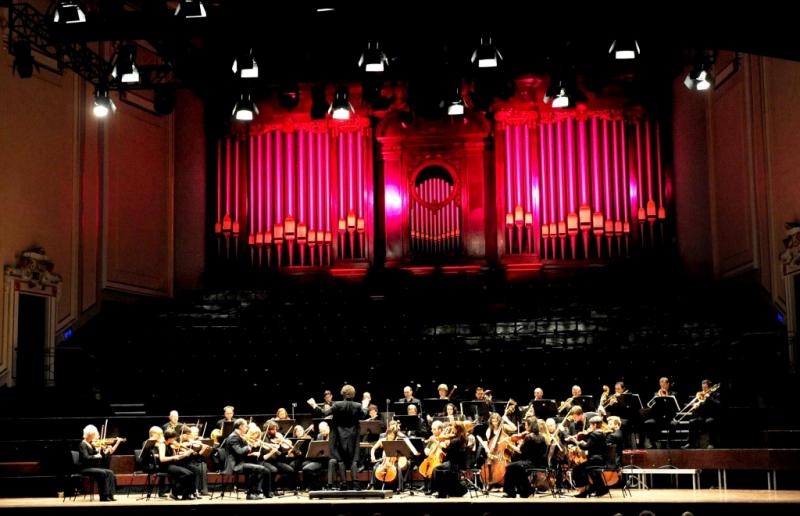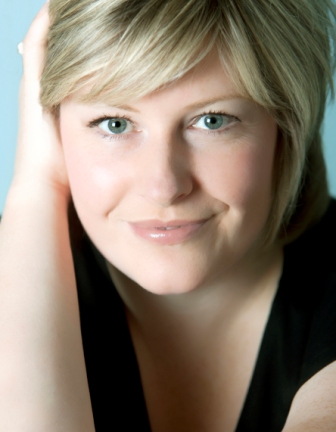Cargill, Yoshino, SCO, Ticciati, Usher Hall, Edinburgh | reviews, news & interviews
Cargill, Yoshino, SCO, Ticciati, Usher Hall, Edinburgh
Cargill, Yoshino, SCO, Ticciati, Usher Hall, Edinburgh
Chamber orchestra pushes boundaries with sinewy Mahler

“Mahler, with a chamber orchestra?” In his introduction to the Scottish Chamber Orchestra’s winter season brochure, principal conductor Robin Ticciati anticipates the reaction of an audience brought up to believe that a chamber orchestra leaves its comfort zone somewhere in the early 19th Century.
In some instances the SCO has expanded its repertoire by expanding the orchestra, a recent example being the gargantuan (and unrecognisable) band put together to accompany Ute Lemper during the 2014 Edinburgh Festival. So I was curious to see what sort of orchestra Ticciati would field for Mahler’s Fourth Symphony. This is the composer's most slender symphonic offering, but would Ticciati get away with a true chamber orchestra (with sleighbells, of course) or would he end up with a de facto symphony orchestra? I imagined him, in rehearsal, a bit like Mahler at the Vienna Opera, impatiently casting around, demanding more strings, more noise, bigger drums, until the orchestra were large enough to cope with the score.
In the event, I counted over 50 players on stage, quite a lot more than you would need for a Haydn symphony, but the look, feel, and tone of the ensemble was definitely that of a chamber orchestra. Mahler with these forces is lucid, transparent, and rather sinewy. With fewer strings to veil the sound, Mahler’s intricate writing for woodwind is prominent to the point that it seems over-exposed, almost a bit chilly. I noticed first clarinettist Maximiliano Martin dutifully raising his bell above the music stand, as Mahler requests, and tooting away like H.E. Bateman’s “one note man”, but such an exhibition was scarcely necessary.
 If the notes were there, and of course they were, all beautifully played by these outstanding musicians, did it add up to a true Mahlerian experience? For this listener the answer has to be “no”: not because the answer “yes” would undermine almost every other performance anywhere in the world, but because the lack of weight in the strings was unable to provide an effective emotional counterweight to the rest of the orchestra. You perhaps don’t miss it until you try and manage without it, but Mahler demands more than just clarity from his big string themes: implicit in the writing is a sense of breadth and fullness that, for all their efforts, could not be conveyed by such small forces, particularly in the wide open spaces of the Usher Hall. The cellos, in particular, have some key moments that were perfectly audible and played with great enthusiasm, but they needed more than six.
If the notes were there, and of course they were, all beautifully played by these outstanding musicians, did it add up to a true Mahlerian experience? For this listener the answer has to be “no”: not because the answer “yes” would undermine almost every other performance anywhere in the world, but because the lack of weight in the strings was unable to provide an effective emotional counterweight to the rest of the orchestra. You perhaps don’t miss it until you try and manage without it, but Mahler demands more than just clarity from his big string themes: implicit in the writing is a sense of breadth and fullness that, for all their efforts, could not be conveyed by such small forces, particularly in the wide open spaces of the Usher Hall. The cellos, in particular, have some key moments that were perfectly audible and played with great enthusiasm, but they needed more than six.
Forget all that, if you would, for the last movement, when the balance (and it is all about balance) is completely recalibrated for the soprano soloist, or in this case the mezzo Karen Cargill (pictured above). This was easily the most successful movement, Cargill soft and shaded, her "Himmlische Leben" (heavenly life) more thoughtful and less joyful than you might expect. Next week she joins forces with the same orchestra but in the smaller space of the Queen’s Hall, for Mahler’s Kindertotenlieder, a combination that on last night’s evidence should be memorable.
The concert began with a nearly-new commission, a harp concerto by the Japanese composer Toshio Hosokawa titled Aeolus, Re-Turning III, performed in a new arrangement in front of a smaller orchestra by Naoko Yoshino. This was an almost entirely static work, with strange seductive gasps from the orchestra, eerie glissandi strings, and only occasional bursts of energy from the brass. A persistent bass drum and three triangles provided a filmic underscore to music whose lack of melodic or rhythmic impulse could not be saved by fleeting moments of intense orchestral beauty.
- This concert is repeated tonight at Glasgow City Halls
Add comment
The future of Arts Journalism
You can stop theartsdesk.com closing!
We urgently need financing to survive. Our fundraising drive has thus far raised £49,000 but we need to reach £100,000 or we will be forced to close. Please contribute here: https://gofund.me/c3f6033d
And if you can forward this information to anyone who might assist, we’d be grateful.

Subscribe to theartsdesk.com
Thank you for continuing to read our work on theartsdesk.com. For unlimited access to every article in its entirety, including our archive of more than 15,000 pieces, we're asking for £5 per month or £40 per year. We feel it's a very good deal, and hope you do too.
To take a subscription now simply click here.
And if you're looking for that extra gift for a friend or family member, why not treat them to a theartsdesk.com gift subscription?
more Classical music
 Bizet in 150th anniversary year: rich and rare French offerings from Palazzetto Bru Zane
Specialists in French romantic music unveil a treasure trove both live and on disc
Bizet in 150th anniversary year: rich and rare French offerings from Palazzetto Bru Zane
Specialists in French romantic music unveil a treasure trove both live and on disc
 Scottish Chamber Orchestra, Ibragimova, Queen’s Hall, Edinburgh review - rarities, novelties and drumrolls
A pity the SCO didn't pick a better showcase for a shining guest artist
Scottish Chamber Orchestra, Ibragimova, Queen’s Hall, Edinburgh review - rarities, novelties and drumrolls
A pity the SCO didn't pick a better showcase for a shining guest artist
 Kilsby, Parkes, Sinfonia of London, Wilson, Barbican review - string things zing and sing in expert hands
British masterpieces for strings plus other-worldly tenor and horn - and a muscular rarity
Kilsby, Parkes, Sinfonia of London, Wilson, Barbican review - string things zing and sing in expert hands
British masterpieces for strings plus other-worldly tenor and horn - and a muscular rarity
 From Historical to Hip-Hop, Classically Black Music Festival, Kings Place review - a cluster of impressive stars for the future
From quasi-Mozartian elegance to the gritty humour of a kitchen inspection
From Historical to Hip-Hop, Classically Black Music Festival, Kings Place review - a cluster of impressive stars for the future
From quasi-Mozartian elegance to the gritty humour of a kitchen inspection
 Shibe, LSO, Adès, Barbican review - gaudy and glorious new music alongside serene Sibelius
Adès’s passion makes persuasive case for the music he loves, both new and old
Shibe, LSO, Adès, Barbican review - gaudy and glorious new music alongside serene Sibelius
Adès’s passion makes persuasive case for the music he loves, both new and old
 Anja Mittermüller, Richard Fu, Wigmore Hall review - a glorious hall debut
The Austrian mezzo shines - at the age of 22
Anja Mittermüller, Richard Fu, Wigmore Hall review - a glorious hall debut
The Austrian mezzo shines - at the age of 22
 First Person: clarinettist Oliver Pashley on the new horizons of The Hermes Experiment's latest album
Compositions by members of this unusual quartet feature for the first time
First Person: clarinettist Oliver Pashley on the new horizons of The Hermes Experiment's latest album
Compositions by members of this unusual quartet feature for the first time
 Gesualdo Passione, Les Arts Florissants, Amala Dior Company, Barbican review - inspired collaboration excavates the music's humanity
At times it was like watching an anarchic religious procession
Gesualdo Passione, Les Arts Florissants, Amala Dior Company, Barbican review - inspired collaboration excavates the music's humanity
At times it was like watching an anarchic religious procession
 Classical CDs: Camels, concrete and cabaret
An influential American composer's 90th birthday box, plus British piano concertos and a father-and-son duo
Classical CDs: Camels, concrete and cabaret
An influential American composer's 90th birthday box, plus British piano concertos and a father-and-son duo
 Cockerham, Manchester Camerata, Sheen, Martin Harris Centre, Manchester review - re-enacting the dawn of modernism
Two UK premieres added to three miniatures from a seminal event of January 1914
Cockerham, Manchester Camerata, Sheen, Martin Harris Centre, Manchester review - re-enacting the dawn of modernism
Two UK premieres added to three miniatures from a seminal event of January 1914
 Kempf, Brno Philharmonic, Davies, Bridgewater Hall, Manchester review - European tradition meets American jazz
Bouncing Czechs enjoy their Gershwin and Brubeck alongside Janáček and Dvořák
Kempf, Brno Philharmonic, Davies, Bridgewater Hall, Manchester review - European tradition meets American jazz
Bouncing Czechs enjoy their Gershwin and Brubeck alongside Janáček and Dvořák
 Solomon, OAE, Butt, QEH review - daft Biblical whitewashing with great choruses
Even a top soprano and mezzo can’t make this Handel paean wholly convincing
Solomon, OAE, Butt, QEH review - daft Biblical whitewashing with great choruses
Even a top soprano and mezzo can’t make this Handel paean wholly convincing

Comments
I was at this concert and
For what it's worth, I've
For what it's worth, I've also been very moved by Erwin Stein's chamber arrangement, which of course is for much smaller forces. Every loss is matched by a gain, and some revelations.
I was interested, in talking to the thoughtful and honest Robin Ticciati, to hear him voicing all the reservations people might feel about his SCO Berlioz Symphonie Fantastique, and yet that too I found revelatory. I hope Linn are taking this into the recording studio too.
I too love the Mahler chamber
I too love the Mahler chamber versions -- Stein, Schoenberg -- which completely re-invent these large scale works as chamber music, brilliantly too. The Edinburgh Festival once did Das Lied in full score and then chamber versions in one evening: the latter was by far the most moving. I might have added in the review that there is ample justification for trying out Maher symphonies with varying orchestral forces as this sort of accommodation was very much his own forte as a conductor -- he fearlessly re-orchestrated other composers to suit the circumstances. So I would never dismiss out of hand a similar approach to another symphony -- this one was simply not to my taste.